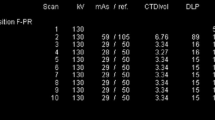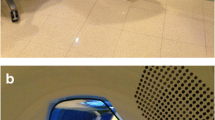Abstract
Background
Reduced-dose C-arm computed tomography (CT) uses flat-panel detectors to acquire real-time 3-D images in the interventional radiology suite to assist with anatomical localization and procedure planning.
Objective
To describe dose-reduction techniques for C-arm CT at a pediatric institution and to provide guidance for implementation.
Materials and methods
We conducted a 5-year retrospective study on procedures using an institution-specific reduced-dose protocol: 5 or 8 s Dyna Rotation, 248/396 projection images/acquisition and 0.1–0.17 μGy/projection dose at the detector with 0.3/0.6/0.9-mm copper (Cu) filtration. We categorized cases by procedure type and average patient age and calculated C-arm CT and total dose area product (DAP).
Results
Two hundred twenty-two C-arm CT-guided procedures were performed with a dose-reduction protocol. The most common procedures were temporomandibular and sacroiliac joint injections (48.6%) and sclerotherapy (34.2%). C-arm CT was utilized in cases of difficult percutaneous access in less common applications such as cecostomy and gastrostomy placement, foreign body retrieval and thoracentesis. C-arm CT accounted for between 9.9% and 80.7% of the total procedural DAP.
Conclusion
Dose-reducing techniques can preserve image quality for intervention while reducing radiation exposure to the child. This technology has multiple applications within pediatric interventional radiology and can be considered as an adjunctive imaging tool in a variety of procedures, particularly when percutaneous access is challenging despite routine fluoroscopic or ultrasound guidance.






Similar content being viewed by others
References
Wallace MJ, Kuo MD, Glaiberman C et al (2008) Three-dimensional C-arm cone-beam CT: applications in the interventional suite. J Vasc Interv Radiol 19:799–813
Angle JF (2013) Cone-beam CT: vascular applications. Tech Vasc Interv Radiol 16:144–149
Racadio JM, Babic D, Homan R et al (2007) Live 3D guidance in the interventional radiology suite. AJR Am J Roentgenol 189:1523
Glatz AC, Zhu X, Gillespie MJ et al (2010) Use of angiographic CT imaging in the cardiac catheterization laboratory for congenital heart disease. JACC Cardiovasc Imaging 3:1149–1157
Hawkins CM, Kukreja K, Singewald T et al (2016) Use of cone-beam CT and live 3-D needle guidance to facilitate percutaneous nephrostomy and nephrolithotripsy access in children and adolescents. Pediatr Radiol 46:570–574
Delgado J, Bedoya MA, Gaballah M et al (2014) Percutaneous sclerotherapy of foot venous malformations: evaluation of clinical response. Clin Radiol 69:931–938
Braak SJ, Van Strijen MJL, Van Es HW et al (2011) Effective dose during needle interventions: cone-beam CT guidance compared with conventional CT guidance. J Vasc Interv Radiol 22:455–461
Hwang HS, Chung MJ, Lee JW et al (2010) C-arm cone-beam CT-guided percutaneous transthoracic lung biopsy: usefulness in evaluation of small pulmonary nodules. AJR Am J Roentgenol 195:W400–W407
Cheng EY, Naranje SM, Ritenour ER (2014) Radiation dosimetry of intraoperative cone-beam compared with conventional CT for radiofrequency ablation of osteoid osteoma. J Bone Joint Surg Am 96:735–742
Ben-Shlomo A, Cohen D, Bruckheimer E et al (2016) Comparing effective doses during image-guided core needle biopsies with computed tomography versus C-arm cone beam CT using adult and pediatric phantoms. Cardiovasc Intervent Radiol 39:732–739
Shellikeri S, Setser RM, Hwang TJ et al (2017) Real-time fluoroscopic needle guidance in the interventional radiology suite using navigational software for percutaneous bone biopsies in children. Pediatr Radiol 47:963–973
Perry BC, Monroe EJ, McKay T et al (2017) Pediatric percutaneous osteoid osteoma ablation: cone-beam CT with fluoroscopic overlay versus conventional CT guidance. Cardiovasc Intervent Radiol. https://doi.org/10.1007/s00270-017-1685-2
Zhu X, Felice M, Johnson L et al (2011) Developing low-dose C-arm CT imaging for temporomandibular joint (TMJ) disorder in interventional radiology. Pediatr Radiol 41:476–482
Thakor AS, Patel PA, Gu R et al (2016) MR cone-beam CT fusion image overlay for fluoroscopically guided percutaneous biopsies in pediatric patients. Pediatr Radiol 46:407–412
Author information
Authors and Affiliations
Corresponding author
Ethics declarations
Conflicts of interest
None
Rights and permissions
About this article
Cite this article
Acord, M., Shellikeri, S., Vatsky, S. et al. Reduced-dose C-arm computed tomography applications at a pediatric institution. Pediatr Radiol 47, 1817–1824 (2017). https://doi.org/10.1007/s00247-017-3964-0
Received:
Revised:
Accepted:
Published:
Issue Date:
DOI: https://doi.org/10.1007/s00247-017-3964-0




